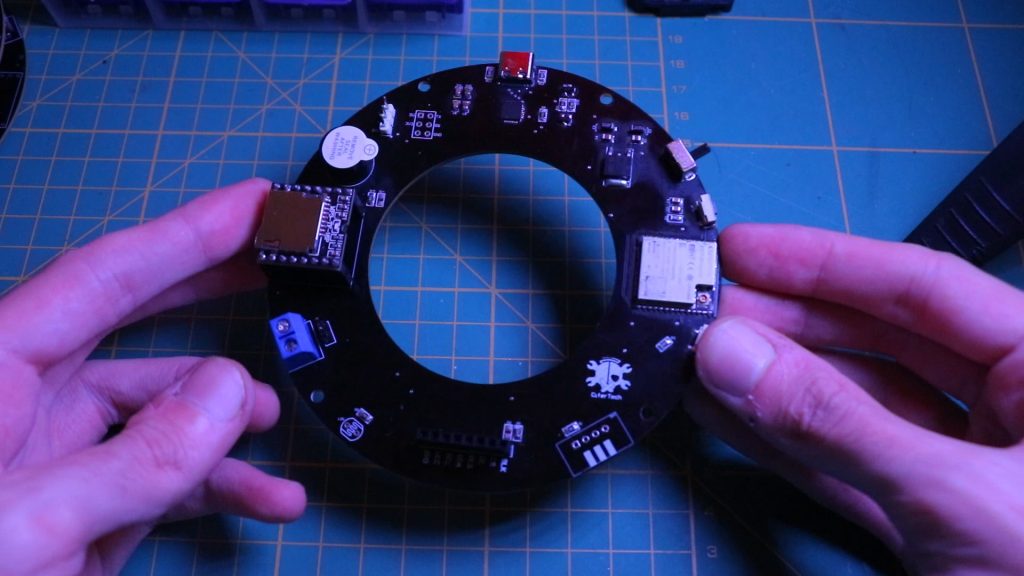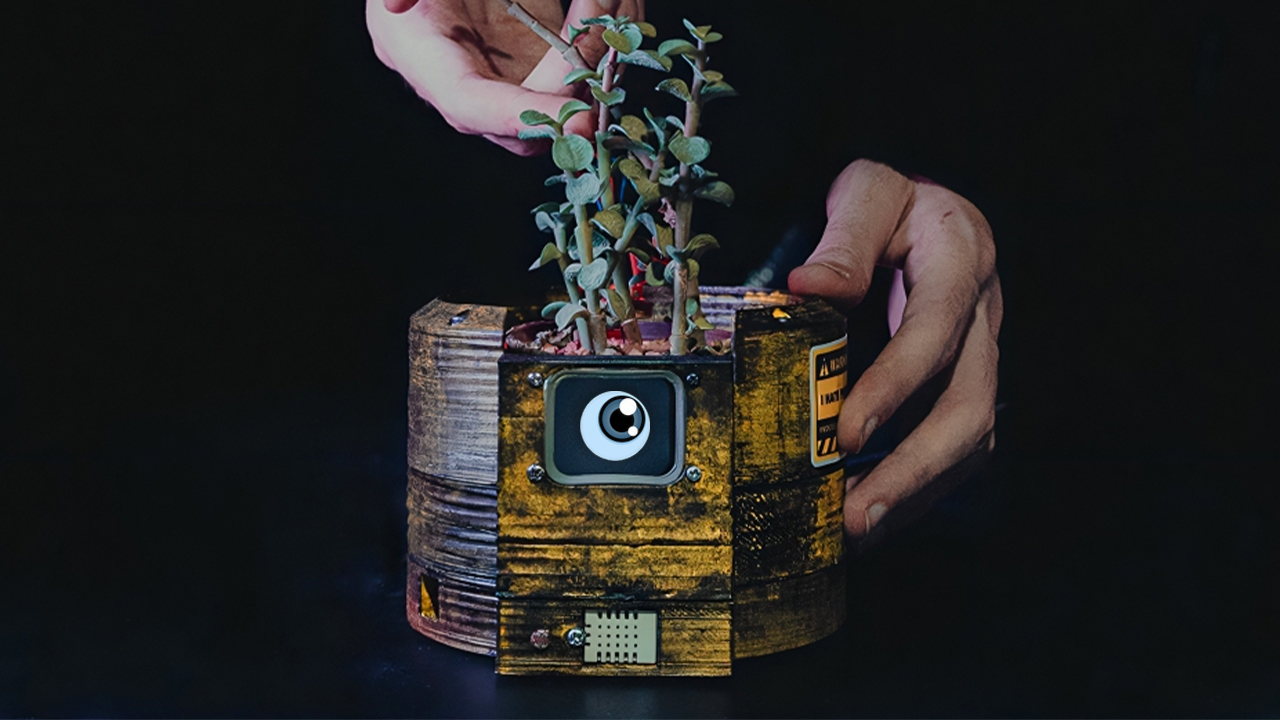Ideas find and claim us; we are merely their vessels, not their architects. This phrase perfectly captures the inspiration behind my latest project: a smart plant pot with a touch of personality!
Last year, I built my first smart pot prototype, but it just didn’t feel complete. After reflecting on what I wanted it to achieve, I set out to make a new version that could truly interact with its environment. This blog post will take you through each step of the journey, from 3D design to coding animations and assembling the electronics that bring this smart pot to life.
🌟 About the Smart Pot Project
The Smart Pot project began as an idea to create something more than just a functional planter. My goal was to bring this pot to life, giving it personality and making it interactive with its environment. Initially, I built a prototype over a year ago, but it didn’t fully capture my vision. After refining my ideas, I’m excited to present this new version—a smart pot that not only cares for a plant but also shows how it “feels” about its surroundings.
From 3D design to custom coding, this project has been a blend of creativity and technology. The Smart Pot reacts to light, moisture, temperature, and humidity, giving real-time feedback through an animated “eye” that displays various emotions. Here’s a look at how it all came together.

🎯 Features of the Smart Pot
The Smart Pot is equipped with a set of sensors and displays that work together to monitor plant health and environmental factors. Here are some of its main features:
- ● Expressive Eye Animation: The animated eye gives the Smart Pot a unique personality, displaying different emotions based on sensor inputs.
- ● Environmental Monitoring: Equipped with a DHT22 sensor for temperature and humidity, an LDR to detect light levels, and a soil moisture sensor, the Smart Pot constantly checks its environment.
- ● Modular Electronics with Wi-Fi: The ESP32 microcontroller not only powers the Smart Pot but also offers future expansion options with Wi-Fi capabilities.
- ● Sound Module: A TF player module is included for potential audio responses in future updates, making the Smart Pot capable of “speaking” or playing sounds.
- ● Low-Power Design: Using a 3.3V voltage regulator ensures efficient power use, enabling the pot to stay active longer on minimal energy.
Step 1: Designing in 3D
The first step was designing the structure in Blender. 3D modeling allowed me to visualize how each component would fit together and plan the dimensions for a perfect fit with the electronics. After finalizing the design, I moved on to the 3D printing phase. With my 3D printer, which might be modest but gets the job done, I printed the main shell of the pot.
But, it wasn’t just about function—this smart pot needed a personality! My girlfriend helped bring this idea to life by designing different sets of expressive eyes and even creating a mobile app interface for future expansion. Maybe in the next version, this smart pot will have an interactive app to match!
Step 2: Coding Emotions with Animated Eyes
To make the smart pot truly engaging, I wanted its “eye” to react to environmental changes and plant conditions. So, I wrote the code to animate the eye, allowing it to express a range of emotions and respond based on various sensor readings. The eye can look around randomly, blink, and shift expressions based on signals from the water, light, and temperature sensors.
While experimenting, I discovered an optical lens that would add depth to the eye’s look, but it arrived a bit too late to use in this build. However, I have exciting plans for this lens in future videos!
Step 3: Painting and Assembly – The Smart Pot Takes Shape
With the printed parts in hand, it was time to give them a unique look. I aimed for a retro-tech vibe, something that looked like it had been protecting the plant for years. Although painting isn’t my strong suit, I added a weathered effect to give it character and depth.
Once I had the look I wanted, I moved on to assembling the electronics. Designing a custom PCB was one of the highlights. It was essential to fit the components compactly without obstructing other parts, allowing for a clean look and optimal functionality.
🎨 The Artistic Side of the Smart Pot
To give the Smart Pot an authentic look, I wanted it to feel like an old piece of technology, as if it had been caring for its plant for decades. After designing the structure in Blender and printing the components on my 3D printer, I hand-painted the pot to add a vintage feel. Though painting isn’t my strongest skill, the weathered look gives it character and makes it feel like it has a story of its own.
My girlfriend helped by designing various eye expressions and even a mock-up for a mobile app interface that may be used in future versions. The Smart Pot’s aesthetic makes it more than just a piece of tech—it becomes an art piece in its own right, adding a unique presence to any room.

👀 Use Cases
It’s a smart plant pot that cares more about your plants than you do!
![]()
Code & PCB
The Smart Pot’s “brain” is a custom-designed PCB that neatly integrates all its components. Here’s a breakdown of the key parts:
- ● ESP32: The ESP32 microcontroller is at the core of the Smart Pot, providing Wi-Fi for potential remote monitoring or updates.
- ● DHT22: Measures temperature and humidity to ensure the plant has optimal conditions.
- ● LDR (Light Sensor): Helps monitor light levels, ensuring the plant receives adequate sunlight.
- ● Water Sensor: Keeps track of soil moisture, signaling when the plant needs watering.
- ● Buzzer and TF Player: While not active in the current version, these modules allow the Smart Pot to have audio feedback in future updates.
The project is not completed at the moment. I need to make a few changes before sharing the files and records. Follow me on GitHub for updates. The resources will be available soon.
My GitHub: github.com/cifertech

 Special Thanks to Our Sponsor: JLCPCB
Special Thanks to Our Sponsor: JLCPCB
No project is complete without the right tools and materials. That’s where our sponsor, JLCPCB, stepped in to provide essential support for this project. JLCPCBis a leading provider of high-quality printed circuit boards (PCBs) and PCB assembly services.
Simply head over to jlcpcb.com, upload your PCB design files, select your preferences, and Your custom PCBs are on their way to you in no time.

Get JLCPCB 6-layer PCBs for just $5! Register to get $80 Coupons. Check out the JLCPCB website.
🌟 Conclusion
My improved smart pot is ready to take care of plants and show how it “feels” about their environment. Watching it react with its expressive eye animations has given it a sense of personality, and I’m thrilled with the results.
The Smart Pot represents the fusion of art, design, and technology, creating a unique and interactive planter that’s as much about self-expression as it is about caring for plants. Each part of the project—from 3D design to custom PCB layout—allowed me to create a functional art piece with personality.


